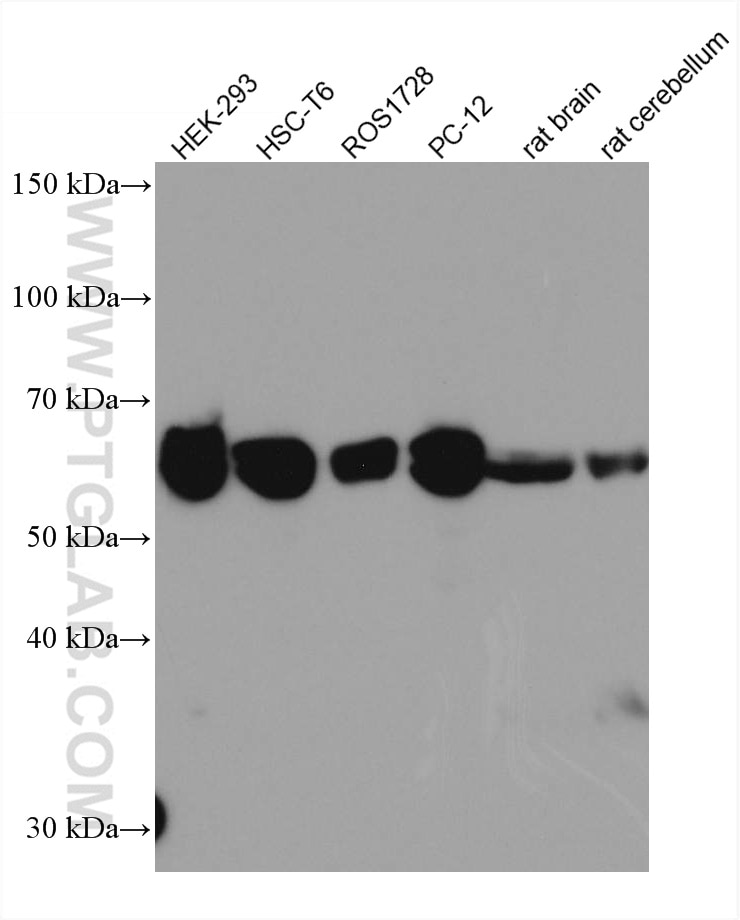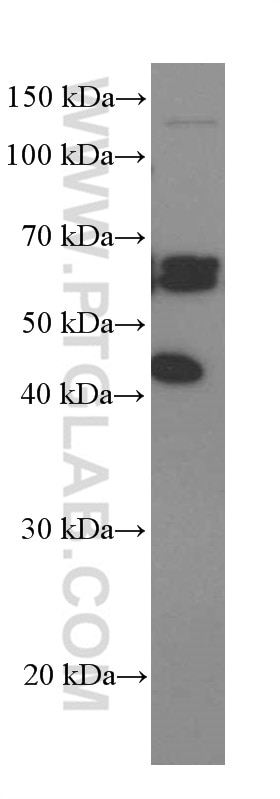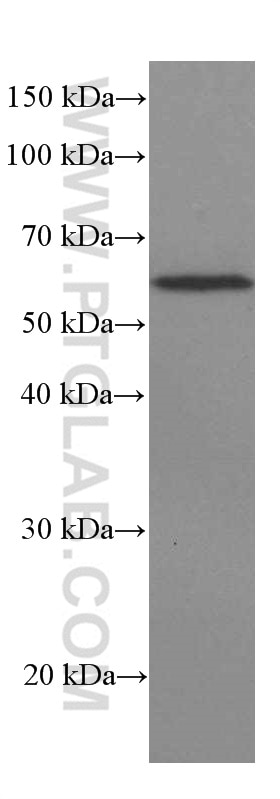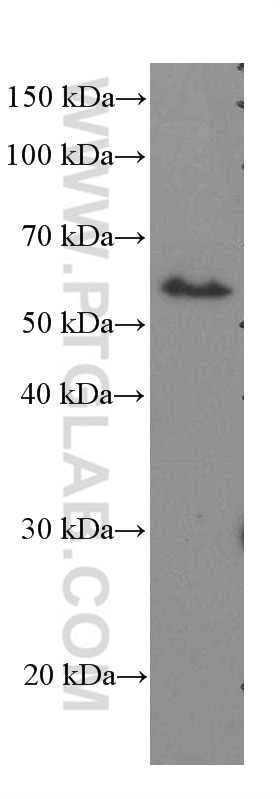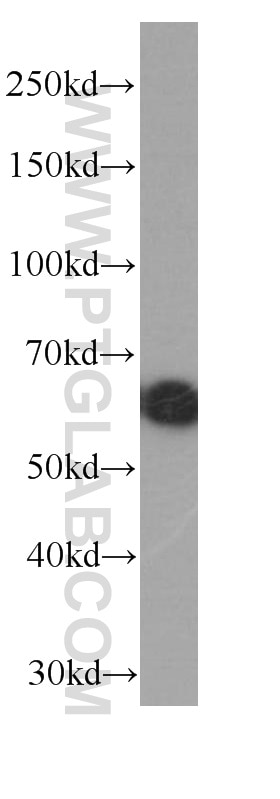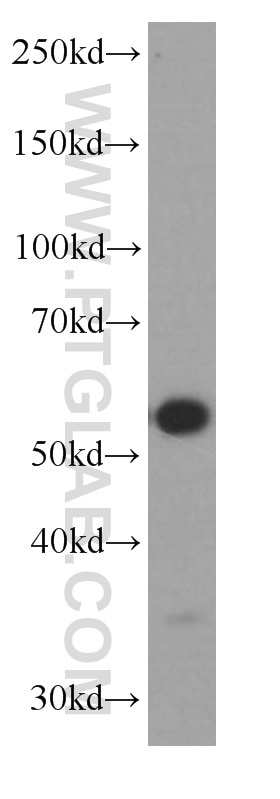Tested Applications
| Positive WB detected in | HEK-293 cells, fetal human brain tissue, SGC-7901 cells, pig brain tissue, mouse brain tissue, HSC-T6 cells, ROS1728 cells, PC-12 cells, rat brain tissue, rat cerebellum tissue |
Recommended dilution
| Application | Dilution |
|---|---|
| Western Blot (WB) | WB : 1:5000-1:50000 |
| It is recommended that this reagent should be titrated in each testing system to obtain optimal results. | |
| Sample-dependent, Check data in validation data gallery. | |
Published Applications
| KD/KO | See 1 publications below |
| WB | See 10 publications below |
Product Information
60112-1-Ig targets IL-1RL1/ST2 in WB, ELISA applications and shows reactivity with human, mouse, rat, pig samples.
| Tested Reactivity | human, mouse, rat, pig |
| Cited Reactivity | human, mouse, pig |
| Host / Isotype | Mouse / IgG1 |
| Class | Monoclonal |
| Type | Antibody |
| Immunogen |
CatNo: Ag2555 Product name: Recombinant human IL-1RL1 protein Source: e coli.-derived, PGEX-4T Tag: GST Domain: 4-328 aa of BC030975 Sequence: WILAILTILMYSTAAKFSKQSWGLENEALIVRCPRQGKPSYTVDWYYSQTNKSIPTQERNRVFASGQLLKFLPAAVADSGIYTCIVRSPTFNRTGYANVTIYKKQSDCNVPDYLMYSTVSGSEKNSKIYCPTIDLYNWTAPLEWFKNCQALQGSRYRAHKSFLVIDNVMTEDAGDYTCKFIHNENGANYSVTATRSFTVKDEQGFSLFPVIGAPAQNEIKEVEIGKNANLTCSACFGKGTQFLAAVLWQLNGTKITDFGEPRIQQEEGQNQSFSNGLACLDMVLRIADVKEEDLLLQYDCLALNLHGLRRHTVRLSRKNPSKECF Predict reactive species |
| Full Name | interleukin 1 receptor-like 1 |
| Calculated Molecular Weight | 63 kDa, 37 kDa, 30 kDa |
| Observed Molecular Weight | 63 kDa |
| GenBank Accession Number | BC030975 |
| Gene Symbol | IL1RL1 |
| Gene ID (NCBI) | 9173 |
| RRID | AB_2264785 |
| Conjugate | Unconjugated |
| Form | Liquid |
| Purification Method | Protein G purification |
| UNIPROT ID | Q01638 |
| Storage Buffer | PBS with 0.02% sodium azide and 50% glycerol, pH 7.3. |
| Storage Conditions | Store at -20°C. Stable for one year after shipment. Aliquoting is unnecessary for -20oC storage. 20ul sizes contain 0.1% BSA. |
Background Information
ST2, also known as IL1RL1, is a member of the IL-1 superfamily and serves as the receptor for IL-33. It plays a major role in immune and inflammatory responses. ST2 is expressed by various types of immune cells including Th2 cells, mast cells, type 2 innate lymphoid cells, eosinophils, basophils, NK cells, and non-immune cells, including cardiomyocytes. Two forms of ST2 exist: a membrane-bound form and a soluble form (sST2). The membrane-bound form activates the MyD88/NF-κB signaling pathway to enhance mast cell, Th2, regulatory T cell (Treg), and innate lymphoid cell type 2 functions. sST2 acts as a decoy receptor. (PMID: 27055914; 23999434; 28484466)
Protocols
| Product Specific Protocols | |
|---|---|
| WB protocol for IL-1RL1/ST2 antibody 60112-1-Ig | Download protocol |
| Standard Protocols | |
|---|---|
| Click here to view our Standard Protocols |
Publications
| Species | Application | Title |
|---|---|---|
Immunity Interleukin-33 Promotes Serotonin Release from Enterochromaffin Cells for Intestinal Homeostasis. | ||
Brain Behav Immun Fibroblast-derived IL-33 exacerbates orofacial neuropathic pain via the activation of TRPA1 in trigeminal ganglion neurons | ||
Neurology Association of Soluble ST2 With Functional Outcome, Perihematomal Edema, and Immune Response After Intraparenchymal Hemorrhage | ||
Sci Rep Dysfunctional EAT thickness may promote maladaptive heart remodeling in CVD patients through the ST2-IL33 system, directly related to EPAC protein expression. | ||
Sci Rep Fatty acid-binding protein 5 limits ILC2-mediated allergic lung inflammation in a murine asthma model. | ||
Cancer Biomark Targeting IL-17alpha to promote anti-PD-1 therapy effect by screening the tumor immune microenvironment in a mouse oral carcinogenesis model |

